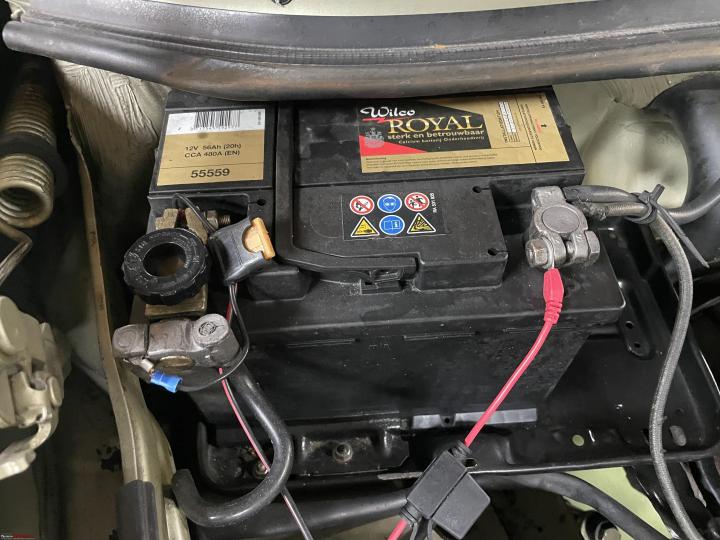News
DIY testing your car's 12V battery: Experience & thoughts
I hooked up the battery tester to my Mercedes W123 to understand how it works.
BHPian Jeroen recently shared this with other enthusiasts.
I recently bought a cheap battery tester. I thought I would share my experience and some thoughts about battery testing in general. This thread is about your regular 12V car battery.
There are many different kinds of batteries on the market. I am not talking about battery capacity, but more about how the battery is constructed and what chemical principle it is based on.
I believe the majority of car batteries in India tend to be what is known as sealed Lead Acid batteries. On more upmarket cars you might find AGM (Absorbed Glass Matt). You might still have a regular lead-acid battery in your car. If you need to check and occasionally top up the battery with distilled water, you have a regular lead acid battery.
This thread is not about what type is best. We have various other excellent threads where this is discussed. This is just about me using my latest toy and sharing some thoughts about these cheap battery testers.
The most obvious way of testing a battery is to hook up a simple voltmeter. Make sure the ignition is off and anything else that might draw power from the battery. You should leave some 10-15 minutes after shutting down the engine for testing. And if you had just started the car and shut it down again, you might want to wait a little longer.
On modern cars, it can be tricky to test the battery voltage. Because modern cars tend to shut down various systems during the first 30-60 minutes. Certainly in the first 10-15 minutes, there might still be a considerable drain on the battery. (For more details see my thread about parasite drains.
Irrespective of the exact type of brand, the rule of thumb a healthy battery would show about 12,6 Volts. Anything below 12,0 Volts is likely to indicate a battery going south.
Just a small word of caution; when you are hooking up your multimeter, make sure the battery terminals, or whatever you attach them to, are very clean. It makes good sense to put a dollop of white Vaseline across battery terminals and connectors. It prevents water ingress and corrosion, but it will also act as a resistor and throw your measurements off.
There are various other "tricks" as well. But it is surprisingly difficult to get a real understanding of your battery status.
Two different parameters give a much better indication of your overall battery status. They are known as SOC (State of Charge) and SOH (State of Health).
You can just glance over the next bit, bit boring all about definitions.
The state of charge of a battery describes the difference between a fully charged battery and the same battery in use. It is associated with the remaining quantity of electricity available in the cell. It is defined as the ratio of the remaining charge in the battery, divided by the maximum charge that can be delivered by the battery. It is expressed as a percentage as below.
The state-of-health (SoH of a battery describes the difference between a battery being studied and a fresh battery and considers cell ageing.
It is defined as the ratio of the maximum battery charge to its rated capacity. It is expressed as a percentage as seen below.
In simple terms, SOC gives you an idea of how much charge your battery has compared to a new battery. SOH gives you an idea about how quickly your battery will drain. The lower the SOH the quicker you exhaust your battery capacity.

If you are interested check out this article that explains all of the above in some more detail.
Those of you who follow my thread on fiddling with my cars might remember that over the last year or so, I have had several problems related to batteries. In some cases, it was the battery, but I also had to replace the alternator and currently, my Jaguar is suffering from a slightly too high quiescent current.
I always had to rely on outside help to get my batteries tested, beyond doing a volt test myself. So I have seen a couple of different battery testers in use. It is surprisingly difficult to find detailed information on what makes a good battery tester. I will come back to this later.
As I buy a lot of stuff from Chinese Websites such as AliExpress and Temu I also get a lot of "tool" related ads in my Facebook feeds and so on. I noticed a little battery tester at Temu. Marked down, from a Whopping Euro 150 to Euro 25. I am a sucker for such bargains, "take my credit card" is my response!!
It arrived within about 10 days.

As you can see a very simple little box. The manual looks more elaborate than it is. Because it holds the text to this little box in about 35 different languages. So don't expect too many details.
It is very simple to use, in theory at least. Again, as with the multimeter make sure you hook it up to clean metal parts of the battery and make sure the battery is not providing power to anything. If it's on a trickle charger take it off.
You need to look for some details on your battery. Such as type and CCA (Cold Case Crank.
Cold Cranking Amps (CCA) measure a battery’s ability to start an engine in cold climates. CCA tells you how many amps a 12-volt battery may support for 30 seconds at -17.8 degrees Celsius before the voltage drops to at least 7.2 volts per cell.
As the ambient temperature drops, your battery provides less and less starting power. However, as the ambient temperature drops your engine will require more and more power to start!

Finding the type of your battery might be a bit of a challenge. None of the six batteries in our fleet of cars had the type of battery mentioned. I had to resort to looking up each battery on the internet.
When you hook up this little battery tester, it powers up automatically. You have to choose the type of battery and also enter the CCA value and against which norm the CCA was measured. (E.g. EN, SAE, IEC etc) Then it will run its almost instant test and come up with three relevant measurements.
The first car I hooked it up to was my Mercedes W123:

Note the sticker showing jaar (year) and maand (month). I checked with the invoice. I bought and installed this battery on March 14, 2015 (my birthday as it so happens!).
This is for today's norms a relatively modest car battery. 56Ah and CCA of 480A
Now let's see what my little, brand spanking new, battery tester thinks of this old battery!!
It tells me the SOH is 75% and still good. Remember this is quite an old battery so it makes sense the SOH is quite low, but still good enough it seems. It also shows the internal resistance


According to the manual, you can get the following readings for the SOH with the respective meanings
- SOH at least 90%: Battery life is perfect
- SOH at least 75%: Battery life is good
- SOH at least 50%: Battery life is bad
- Replace: The battery should be replaced as SOH is less than 50%
- Recharge: Re-test the battery after charging
According to the manual, the tester will tell you when a clamp is not connected properly to the manual. I am not too sure how well that works. Because the next measurement I took on the Jeep and they were pretty awful. But when I reset the two test connectors everything was fine again.
The Jeep has a much larger battery, 74 Ah and a CCA of 680A. I have also replaced it only earlier this year. But it has been completely discharged whilst in the care of the idiot VIP parking at Amsterdam Airport.
So here are the results:
The SOH shows 77%
Just to illustrate you need to choose the correct battery type, or you are going to get a very unreliable reading. Here I am testing the Jeep Battery once again, but I have chosen the type as AGM. (Notice the left-hand vertical bar!)
It tells me the SOH is 43% and to replace the battery!!
In all honesty, I am not yet convinced about this little battery tester. I will keep it and will bring it along when I get my battery tested with some professional battery testers. It seems to give an indication. All battery testers work by applying a load to the battery and monitoring that load. Without going into all the theory of battery tester, I think the more load and the longer it is applied the more reliable the results become. This tiny little box can't simulate much of a load. And the actual testing is almost instantaneous.
Whilst I was tinkering with my digital multimeter and this battery tester I thought I would do another test. Modern cars rely heavily on a good healthy battery. It is worthwhile to note it is more important for a modern car to have a healthy voltage than to have a huge capacity. If the voltage drops below a certain threshold, the car's electronics won't work properly. 10 Volts will still crank your car quite sufficiently, but it might throw your ECU off and consequently, you won't be able to start. Poor battery connections, corrosion or not tightened properly will have the same effect.
As a rule of thumb, the older cars, or rather the electronics, get the more susceptible they are likely to become to a proper supply voltage. Rule of thumb, you don't want it dipping much below 10,5V.
When does your voltage dip? When you switch on your lights, AC whilst the engine is running. But of course, the largest dip is when starting.
So I did a few tests.
I used my Mercedes W123 once again. Because according to my battery tester, it has the battery with the lowest SOH.
I took these little videos with my iPhone as SloMO. That's why the engine sounds more like a diesel.
Look closely. You see the battery voltage at a nominal 12.49V. Then I start the engine and the voltage drops to about 10.4V and comes back up to about 14.4V. The 14.4V with the engine running is a good indication that the alternator is charging. It should be because I replaced it not too long ago.
But doing these sorts of tests with a multimeter can be a bit deceptive. Although the display shows digital numbers and decimals, that in itself does not say anything about the accuracy. Digital multimeters have a sample rate, so they average out the measurements.

Traditional analogue meters are much better at capturing these sorts of Voltage dips. Luckily, I collect old analogue meters.
You will have to take my word for it, the video is a bit shaky, better to see on my iPhone but the voltage drops to almost 8 Volts!! Not a problem for this old car with a carburettor and virtually no fancy electronics.
But it would be a huge problem for a modern engine. It cranks fine, but the voltage crashes which will cause the ECU and other electronic components to go haywire.
It is almost impossible to predict how long a battery will last. So many different factors are involved. If you have a battery that still requires the level of the electrolyte to be checked, do so regularly. Don't let it drop below the minimum level, on any cell.
Most other batteries and certainly the sealed batteries don't require maintenance as such. However, if you can, putting them on one of these fancy trickle chargers does help. They top up the battery, but also discharge and charge it regularly. I am pretty sure one reason the W123 battery is lasting as long as it does, is it being hooked up to my trickle charger always when parked in my garage.

Check out BHPian comments for more insights and information.
- Tags:
- Indian
- Member Content
- car battery
- DIY






.jpg)











